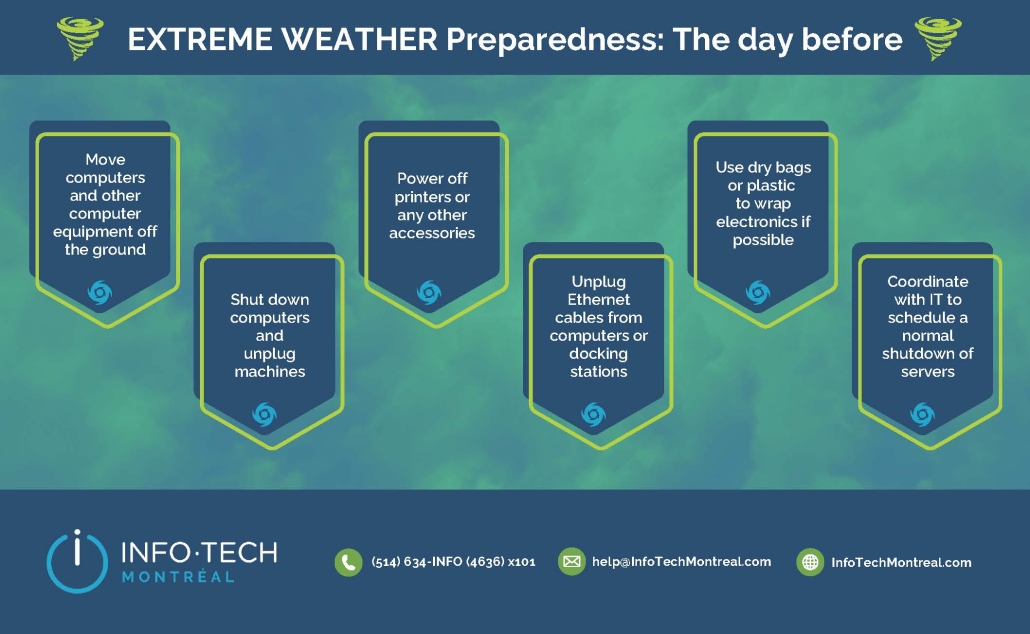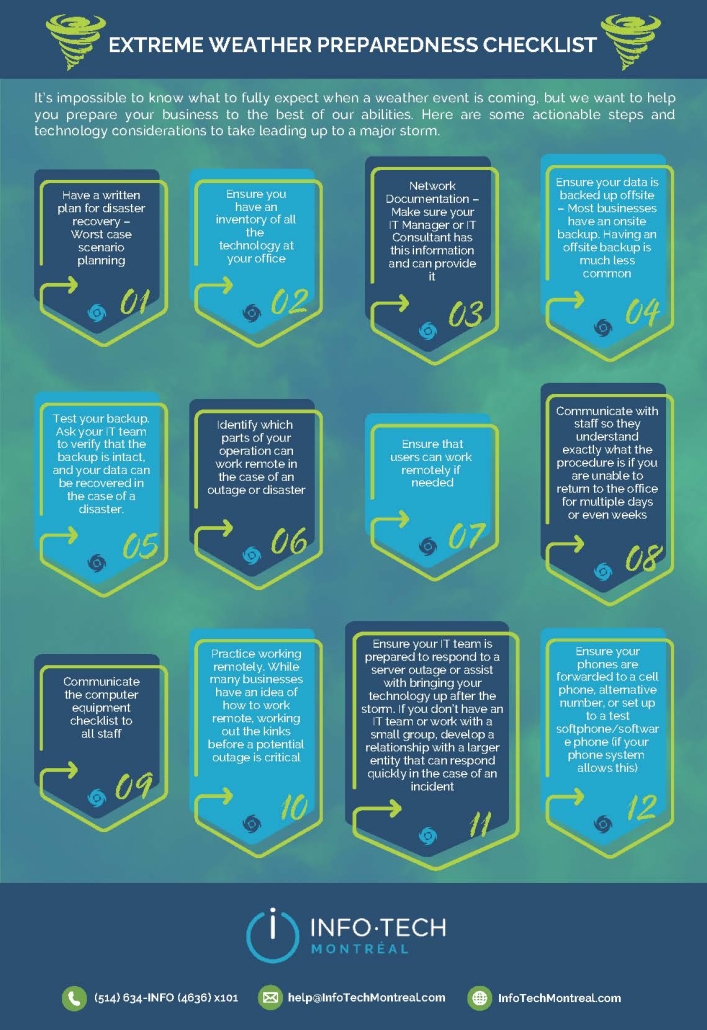Weathering the Storm: 7 Steps to Safeguard Your Business Technology & Data

An imminent extreme weather event poses a concerning problem for all types of businesses. This is especially true for companies that rely on computers and servers since these devices can easily be damaged by storms, floods, or fires. As extreme weather approaches, the 24 hours prior to its arrival are crucial. Business owners need to act fast to protect their expensive equipment and valuable data, making sure the business can still operate normally after the storm passes.
The Importance of Electronic Equipment
Electronics and data storage devices, such as computers and servers, are crucial to businesses. When snow storms or floods occur, these devices can easily be damaged by water and suffer power issues. When your computer breaks down, not only is it expensive to fix or replace it, but you may also lose all of the information you had stored on it. The importance and volume of data that can be lost is a major concern. Therefore, protecting these devices from storms is a top priority.
A List to Prepare Your Business the Day Before the Disaster
If you’re a business owner in Quebec or Ontario, you likely know about the extreme weather season.
Severe weather not only impacts the location where it occurs, but other areas as well. A technical issue in Montreal due to a snowstorm, for instance, can easily disrupt operations in your Toronto or Vancouver office. Hence, safeguarding your technology and data against adverse weather is crucial.
This useful 7-step list will help you get ready for the extreme weather season. Even if you’re not located in a storm-prone area, it’s wise to be prepared. If a storm creates a technical issue that affects your offices, you need to ensure that it does not harm your business.
Protect Your Premises
It may seem obvious, but office spaces require storm readiness. Just as you’d prepare your home to resist a storm, so too must you follow the same guidelines for your business premises. If possible, shut down and disconnect everything on the day before the storm hits.
Protect Your Tech Devices From Water
Everyone understands that water and technology are enemies. Water damage can not only destroy your business’s tech, but also pose a fire hazard due to the possibility of electrical shorts. If you’re in a flood-prone zone, it’s wise to elevate your electronics – place them on desks, tables, or high shelves. Ensure all devices are connected to surge protectors or, better yet, are disconnected entirely before vacating.
Document Your Assets
As you get your tech ready, snap photos and list all your electronic devices and high-value items. If a disaster strikes, having this inventory simplifies the insurance claim process.
Ensure Your Essential Business and Client Information is Saved Securely
At Info-Tech Montreal, we’ve helped many businesses with disaster recovery. We therefore emphasize the importance of data backups. Consider your business suffering a power outage. If you’re forced to operate from a different location, which documents and software would be crucial for remote operations?
This is when remote monitoring and management tools become invaluable. Your IT service partner can assist in setting up offsite data backups, save your information on the cloud, and guarantee remote access to all necessary resources to keep your business running. Contact us and ask us about getting this set-up ASAP.
Establish a Disaster Recovery Strategy
You’ve safeguarded your data, meticulously checked your tech, and even photographed your office, including those unique knick-knacks for insurance purposes, but are you prepared for the aftermath of storm or flood damage? It’s vital to devise a detailed recovery blueprint, specifying roles, contacts, locations, and storage points for crucial items. If partnered with an IT managed service provider like Info-Tech Montreal, your IT crew can offer invaluable assistance with this type of planning.
Make an Offline Contact List
Weather disasters and their aftermath can disrupt power and access to the internet, making communication a challenge. While safeguarding your data, consider creating a list of vital contacts, including staff, clients, and suppliers. Save this on your phone or have a printed copy handy. That way, if you’re offline, you still have quick access to all necessary contacts, ensuring uninterrupted communication.
Run Drills for Weather Disasters Regularly
It’s often said that practice makes perfect. In high-pressure situations, recalling a months-old plan can be tough. On the other hand, following a drill you and your team have consistently practiced is simpler. Even if your location isn’t typically affected by storms or floods, having an extreme weather protocol is essential. Ensure that both you and your staff are well-versed in emergency procedures.
Preparing Your Business for Extreme Weather Disasters with Info-Tech Montreal
With the right preparations, safeguarding your business against extreme weather events and seasonal risks becomes manageable. At Info-Tech Montreal, we offer services like remote IT managed services, and tech consultancy to prepare your business against unforeseen calamities. Regardless of where you’re located within the Montreal and Ottawa areas, or what type of business you have, we remain ready to assist.





